Wabi Sabi invites a sense of calm and authenticity into our personal spaces, embracing the beauty found in imperfection and simplicity. This Japanese philosophy celebrates natural materials, muted color palettes, and the marks of time, creating environments that are grounding and deeply personal. A Wabi Sabi bedroom is more than just a style; it's a sanctuary designed to quiet the mind and soothe the soul. By focusing on organic textures, handcrafted items, and an uncluttered layout, you can transform your bedroom into a serene retreat that honors the transient and imperfect nature of life, fostering a profound connection to your surroundings.
1. Wabi Sabi Bedroom with Earthy Color Palettes
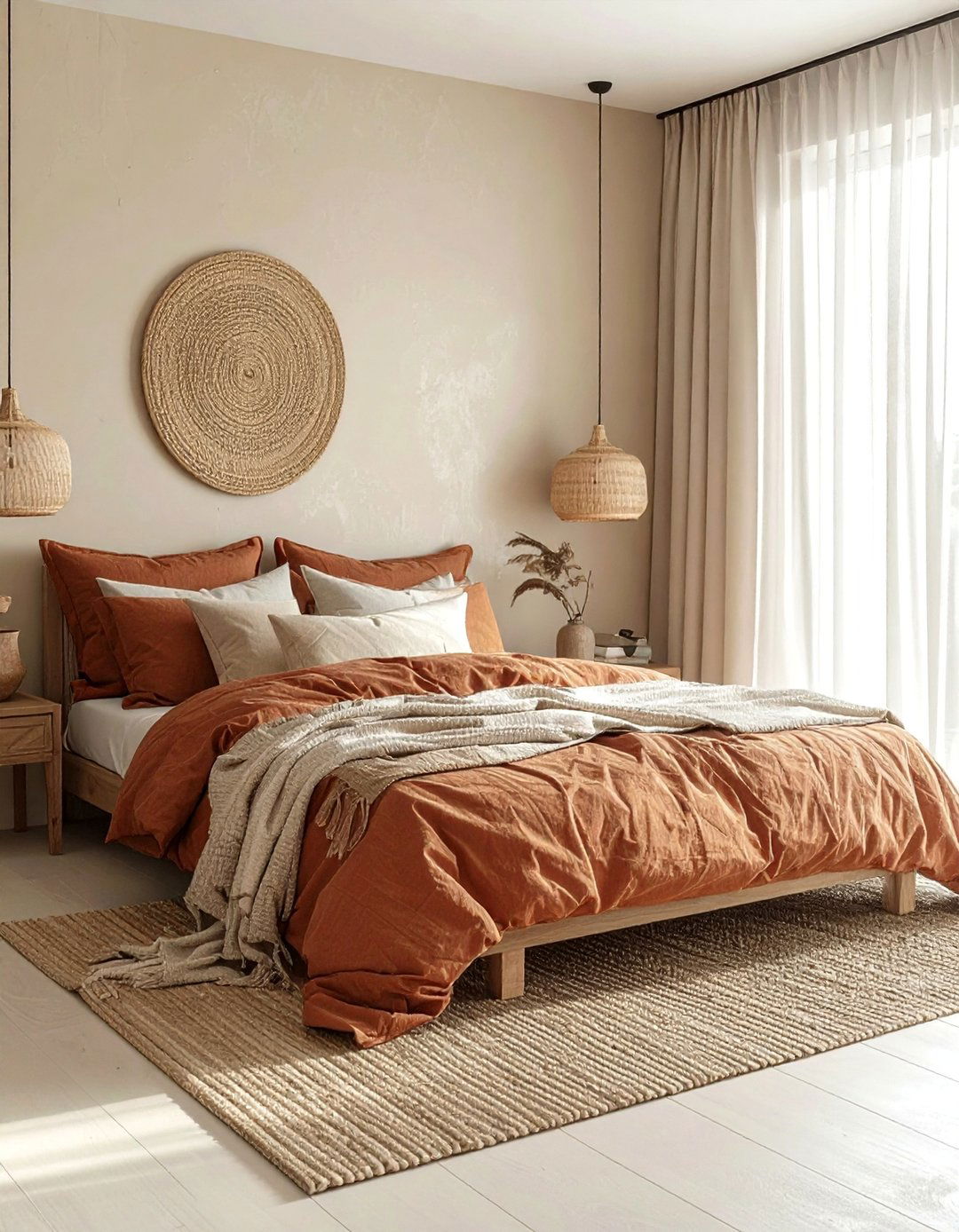
An essential element of a Wabi Sabi bedroom is an earthy and muted color palette that evokes a sense of tranquility. Consider shades of beige, taupe, soft gray, and warm off-whites as your foundation. These colors mimic the natural world, from sandy shores to weathered stone, creating a calming backdrop that soothes the senses. For subtle depth, introduce accents of muted terracotta, olive green, or faded indigo. This approach avoids stark contrasts and loud hues, allowing the room's textures and forms to take center stage. The result is a harmonious space that feels grounded, peaceful, and deeply connected to nature's gentle, unassuming beauty.
2. Wabi Sabi Bedroom Incorporating Natural Materials
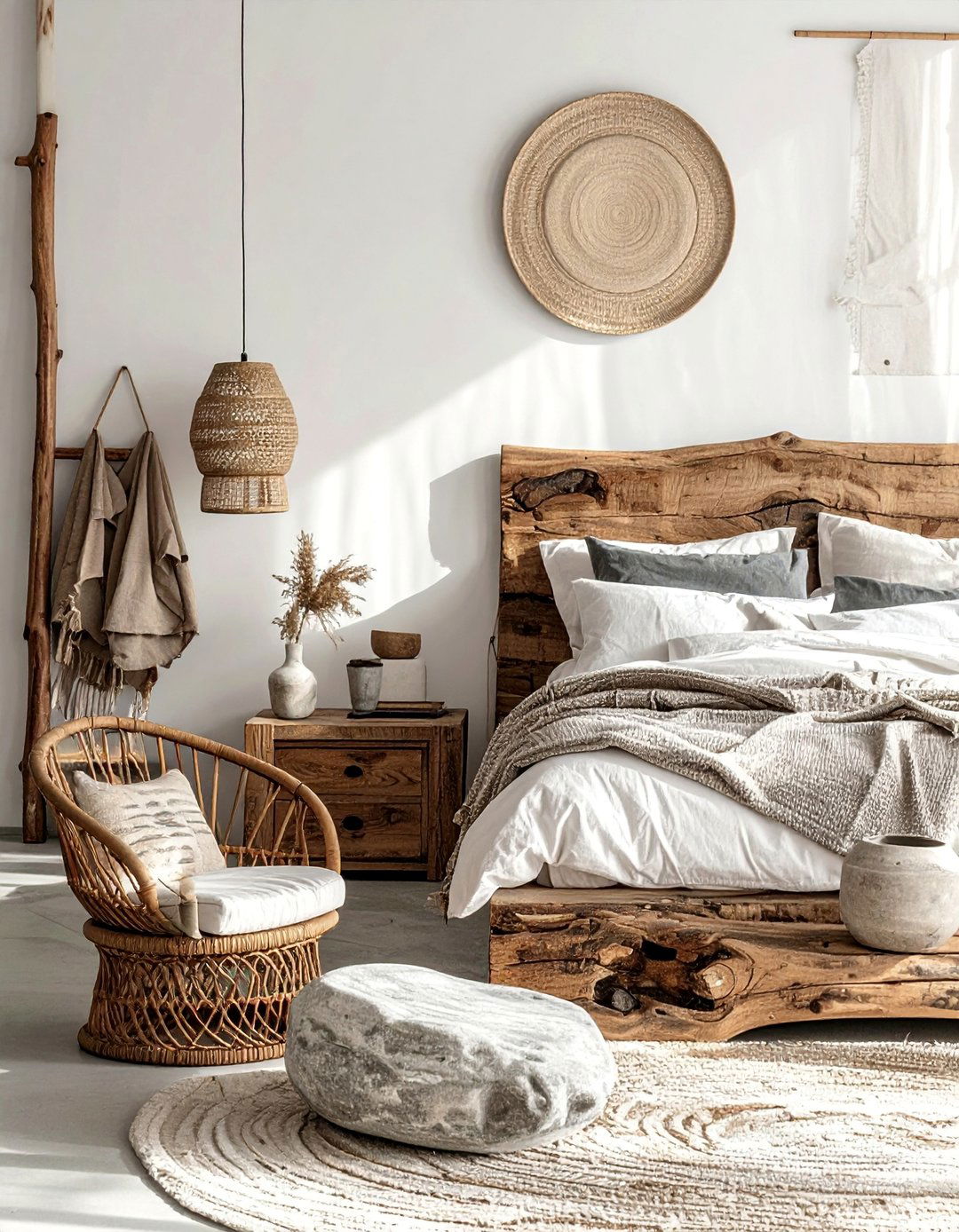
Bringing the outdoors in is fundamental to the Wabi Sabi aesthetic, and using natural materials is the most direct way to achieve this. A Wabi Sabi bedroom thrives on elements like unfinished wood, bamboo, rattan, stone, and clay. Think of a rustic wooden headboard, a simple stone side table, or handcrafted ceramic vases. These materials not only add textural interest but also carry an inherent authenticity and warmth. Their natural imperfections—the grain in the wood, the subtle variations in stone—are celebrated, reminding us of the beauty in rawness and simplicity. This focus on organic elements creates a space that feels honest, tactile, and nurturing.
3. Wabi Sabi Bedroom with Imperfect Textures
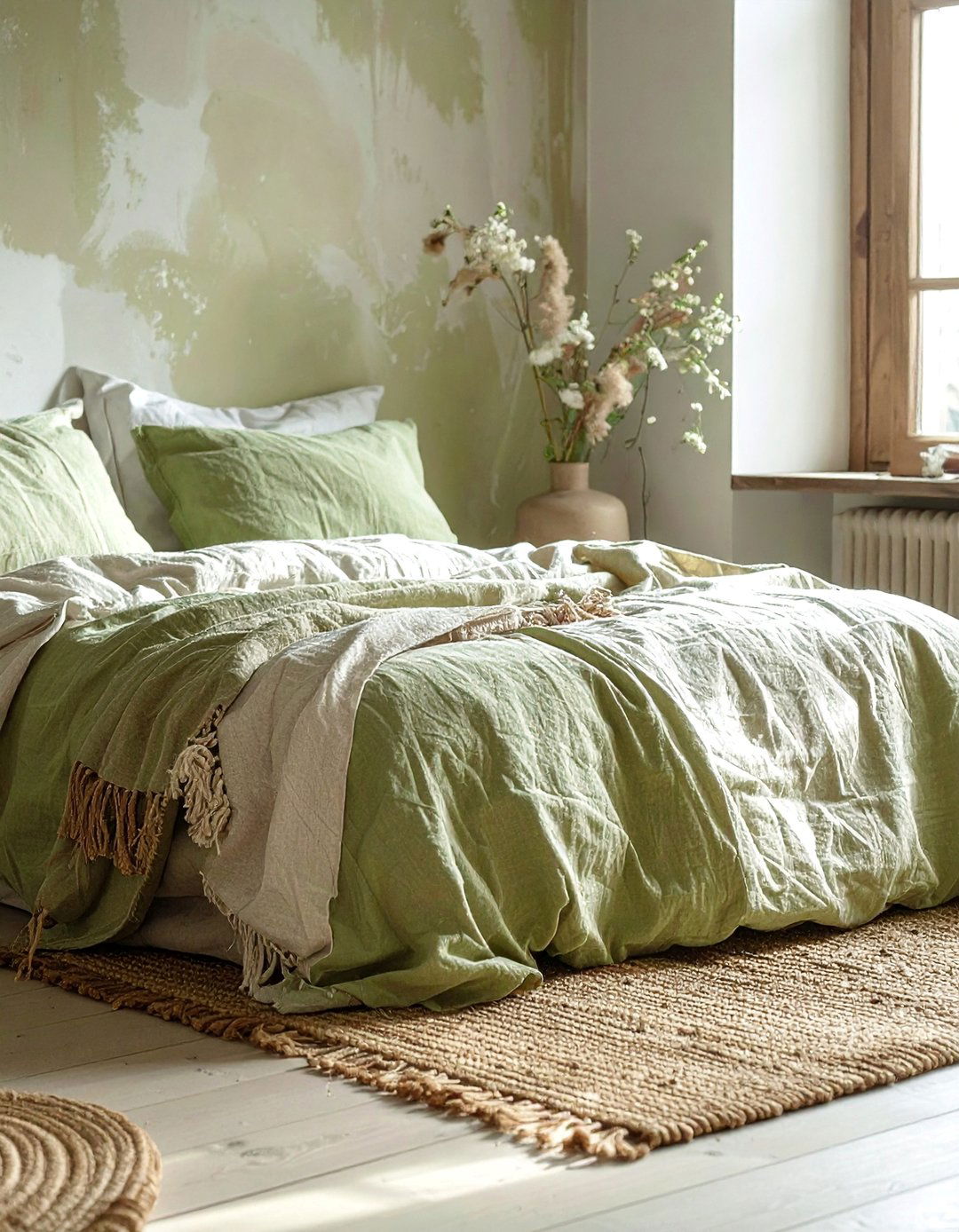
Texture is paramount in a Wabi Sabi bedroom, adding depth and character without relying on color or pattern. Embrace materials with tangible, imperfect surfaces that invite touch. Think of slubby linen bedding, rumpled cotton throws, handwoven wool rugs, and walls with a subtle lime wash or plaster finish. These textures are not meant to be flawless; in fact, their slight irregularities are what make them beautiful. The interplay of rough and smooth surfaces creates a rich sensory experience that is both comforting and visually compelling. This focus on tactile qualities turns the bedroom into a cozy, lived-in sanctuary that feels both humble and sophisticated.
4. Wabi Sabi Bedroom Featuring Minimalist Furniture

Furniture in a Wabi Sabi bedroom should be simple, functional, and thoughtfully chosen. The philosophy emphasizes uncluttered living, so select only essential pieces with clean lines and modest forms. A low-profile wooden bed frame, a simple blocky nightstand, or a handcrafted bench can anchor the room without overwhelming it. The furniture should appear grounded and substantial, often showcasing the natural beauty of its material, like reclaimed wood or bamboo. Avoid ornate details or glossy finishes. The goal is to create a sense of spaciousness and calm, where each piece serves a purpose and contributes to an overall feeling of understated, mindful simplicity.
5. Wabi Sabi Bedroom with Asymmetrical Balance

Wabi Sabi design rejects rigid symmetry in favor of a more organic, natural balance. In a Wabi Sabi bedroom, this means arranging elements asymmetrically to create a dynamic yet harmonious composition. For instance, instead of matching nightstands and lamps, you might pair a small wooden stool on one side of the bed with a low-hanging pendant light on the other. A gallery wall could feature frames of different sizes arranged in an irregular pattern. This approach mirrors the asymmetry found in nature, fostering a sense of gentle movement and visual interest. It makes the space feel less formal and more relaxed, encouraging the eye to wander and appreciate each element individually.
6. Wabi Sabi Bedroom Showcasing Handmade Decor
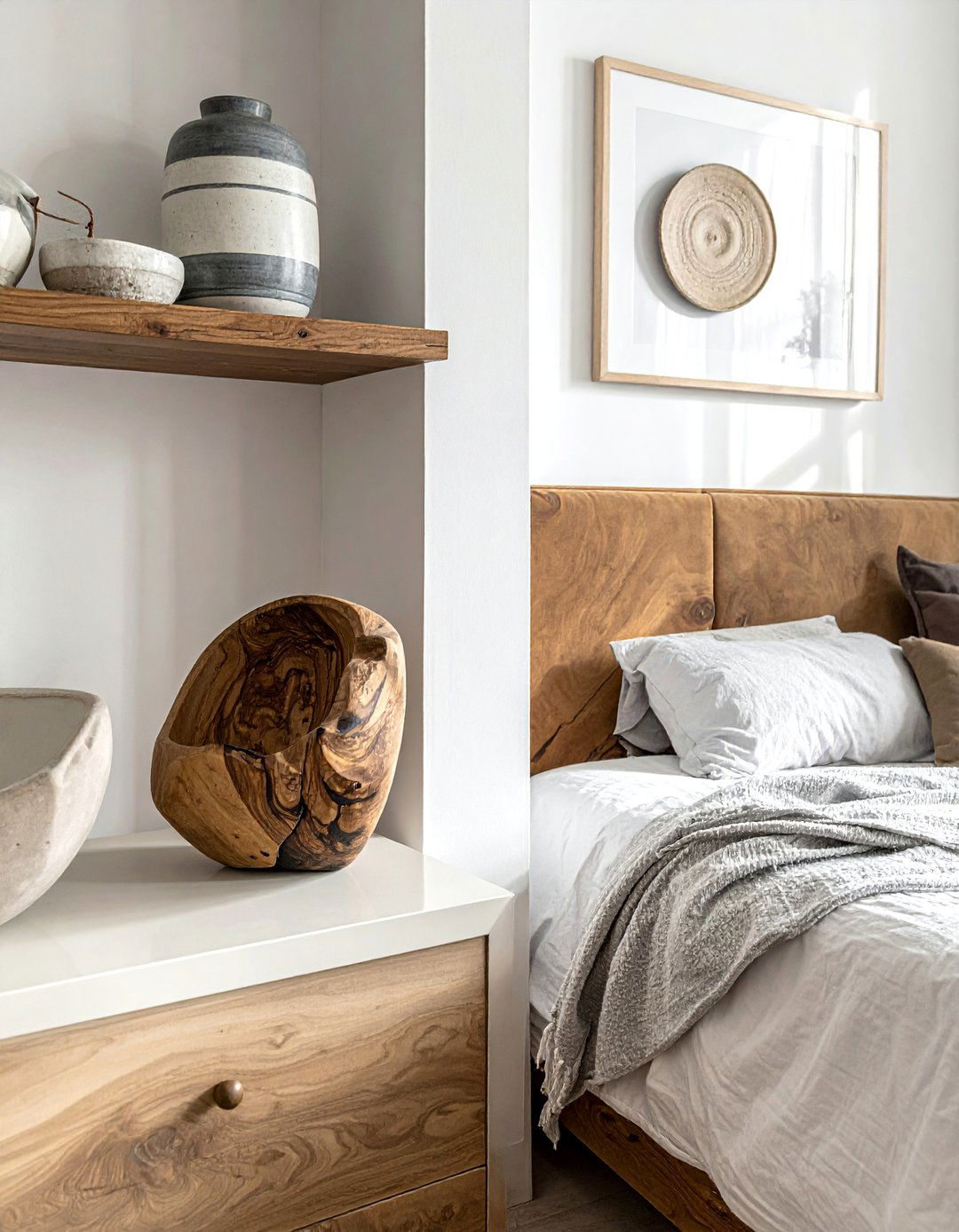
Handcrafted objects are the heart of a Wabi Sabi bedroom, as they carry the story and touch of their maker. Incorporate decor items that are unique and imperfect, such as hand-thrown pottery, a hand-carved wooden bowl, or a woven wall hanging. These pieces celebrate the human element in design and stand in contrast to mass-produced goods. Their slight irregularities and unique characteristics add a layer of soul and personality to the space. By choosing handmade items, you not only support artisans but also infuse your bedroom with a sense of authenticity and history. Each piece becomes a focal point for quiet contemplation, enriching the room's serene atmosphere.
7. Wabi Sabi Bedroom Centered on a Low-Profile Bed

A low-profile bed is a signature feature in many Wabi Sabi bedrooms, helping to create a grounded and humble atmosphere. Placing the mattress on a simple, low-to-the-ground platform or even directly on a sturdy frame emphasizes a connection to the earth. This design choice fosters a sense of stability and tranquility, removing the formality of a tall, imposing bed. Paired with soft, natural bedding like wrinkled linen or organic cotton, the low bed becomes an inviting centerpiece for rest and relaxation. The minimalist silhouette also enhances the feeling of spaciousness in the room, aligning perfectly with the Wabi Sabi principle of appreciating simplicity and negative space.
8. Wabi Sabi Bedroom with Natural Linen Bedding

The choice of bedding is crucial for achieving a Wabi Sabi feel, and natural linen is the perfect material. Its inherent texture, beautiful drape, and slightly wrinkled appearance embody the aesthetic of relaxed imperfection. Unlike crisp, perfectly pressed sheets, linen looks best when it’s soft and lived-in, eliminating the need for fussiness. Choose linen in muted, earthy tones like oatmeal, dusty rose, or soft grey to complement the room's calm palette. Layering linen sheets, a duvet cover, and throw pillows adds tactile depth and creates a cozy, inviting nest. This simple switch can instantly transform the bedroom into a comfortable and effortlessly chic sanctuary.
9. Wabi Sabi Bedroom Using Reclaimed Wood
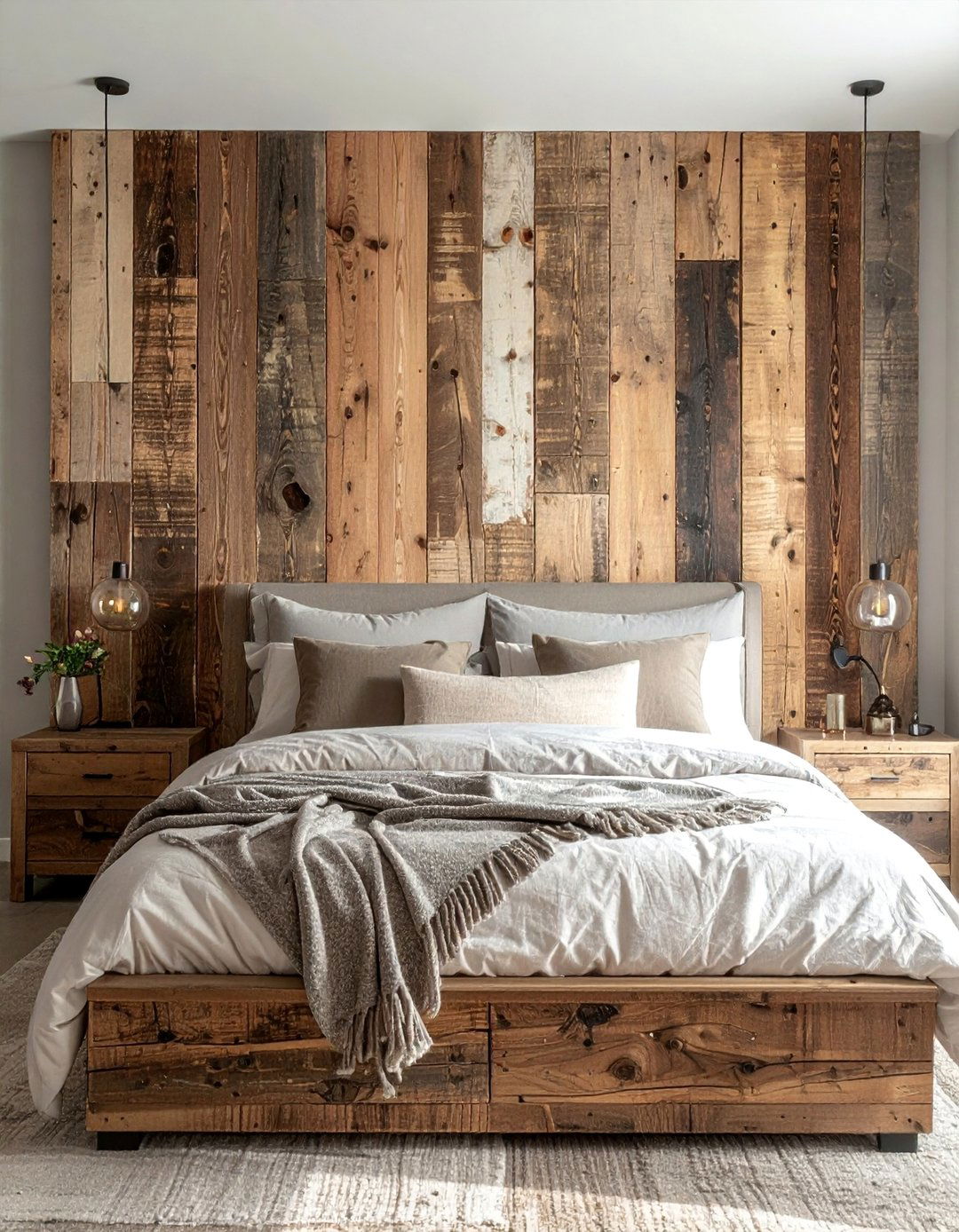
Reclaimed wood brings a rich sense of history and character to a Wabi Sabi bedroom. Each knot, grain pattern, and weathered mark tells a story, celebrating the beauty that comes with age and use. You can incorporate reclaimed wood as a statement headboard, a rustic bench at the foot of the bed, or simple floating shelves. The material’s inherent imperfections and warm patina add instant depth and authenticity to the space, creating a connection to the past. Using reclaimed wood is not only aesthetically pleasing but also a sustainable choice, aligning with the Wabi Sabi value of appreciating existing resources and finding beauty in the overlooked.
10. Wabi Sabi Bedroom with Concrete Accents
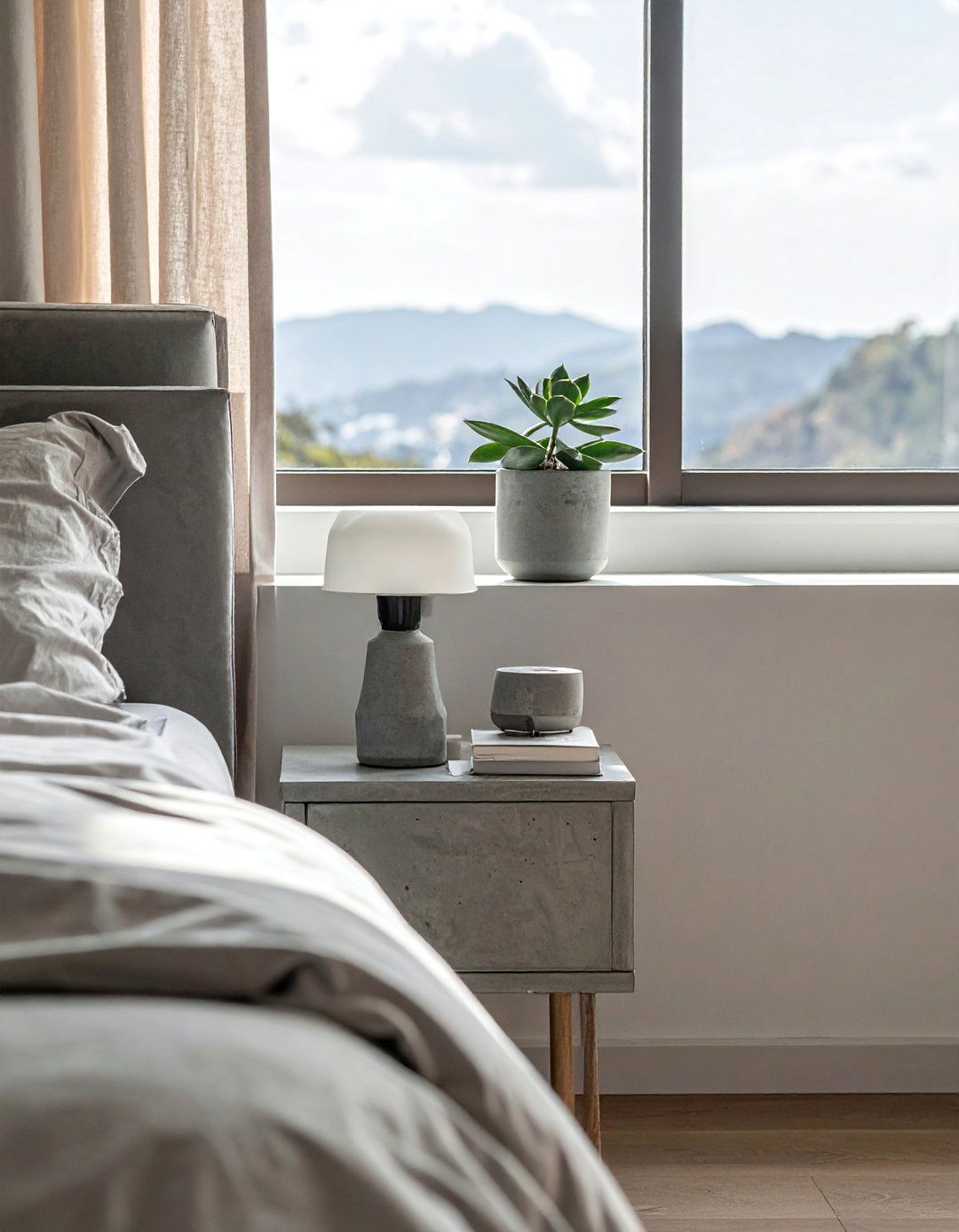
While it may seem industrial, concrete can bring a beautiful, raw texture to a Wabi Sabi bedroom when used thoughtfully. Its cool, earthy quality provides a striking contrast to softer elements like wood and linen. Consider small concrete accents like a minimalist lamp base, a simple tray for holding trinkets, or a small planter. For a bolder statement, a polished concrete floor or a feature wall with a concrete-effect plaster can create a serene, cave-like atmosphere. The material's natural color variations and subtle imperfections make it an ideal fit for the Wabi Sabi philosophy, adding a touch of modern, understated elegance to the space.
11. Wabi Sabi Bedroom Featuring Dried Florals and Branches
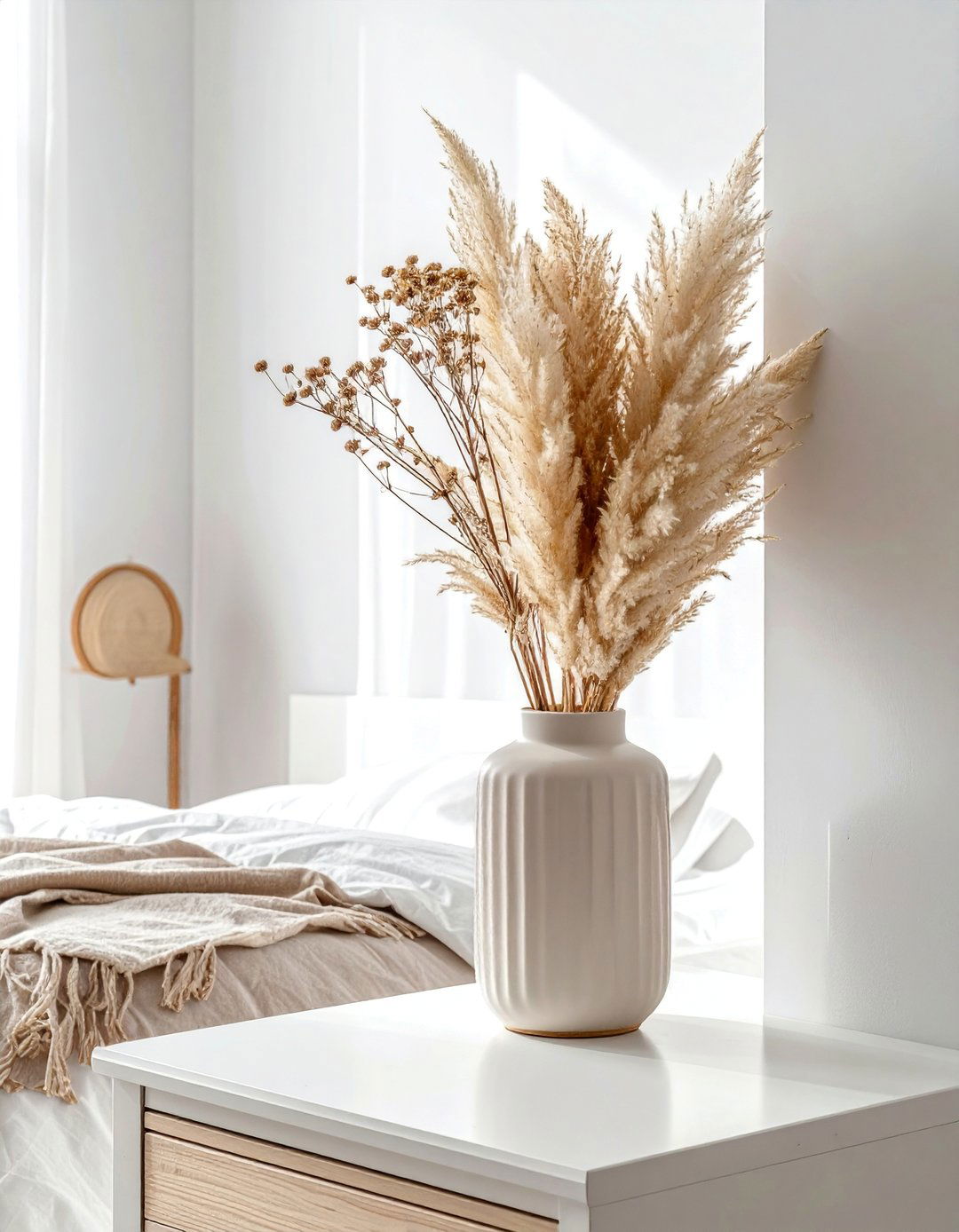
In a Wabi Sabi bedroom, nature is celebrated in all its phases, including decay. Instead of fresh, vibrant flowers, opt for the subtle beauty of dried florals, grasses, and bare branches. A simple arrangement of dried pampas grass in a ceramic vase, a gnarled branch mounted on the wall, or a sprig of dried eucalyptus on a nightstand adds a touch of organic sculpture. These elements capture the transient beauty of nature and possess a quiet, lasting elegance. Their muted colors and delicate forms complement the room's earthy palette and minimalist aesthetic, serving as a gentle reminder of the beauty found in impermanence and simplicity.
12. Wabi Sabi Bedroom with Soft Paper Lanterns
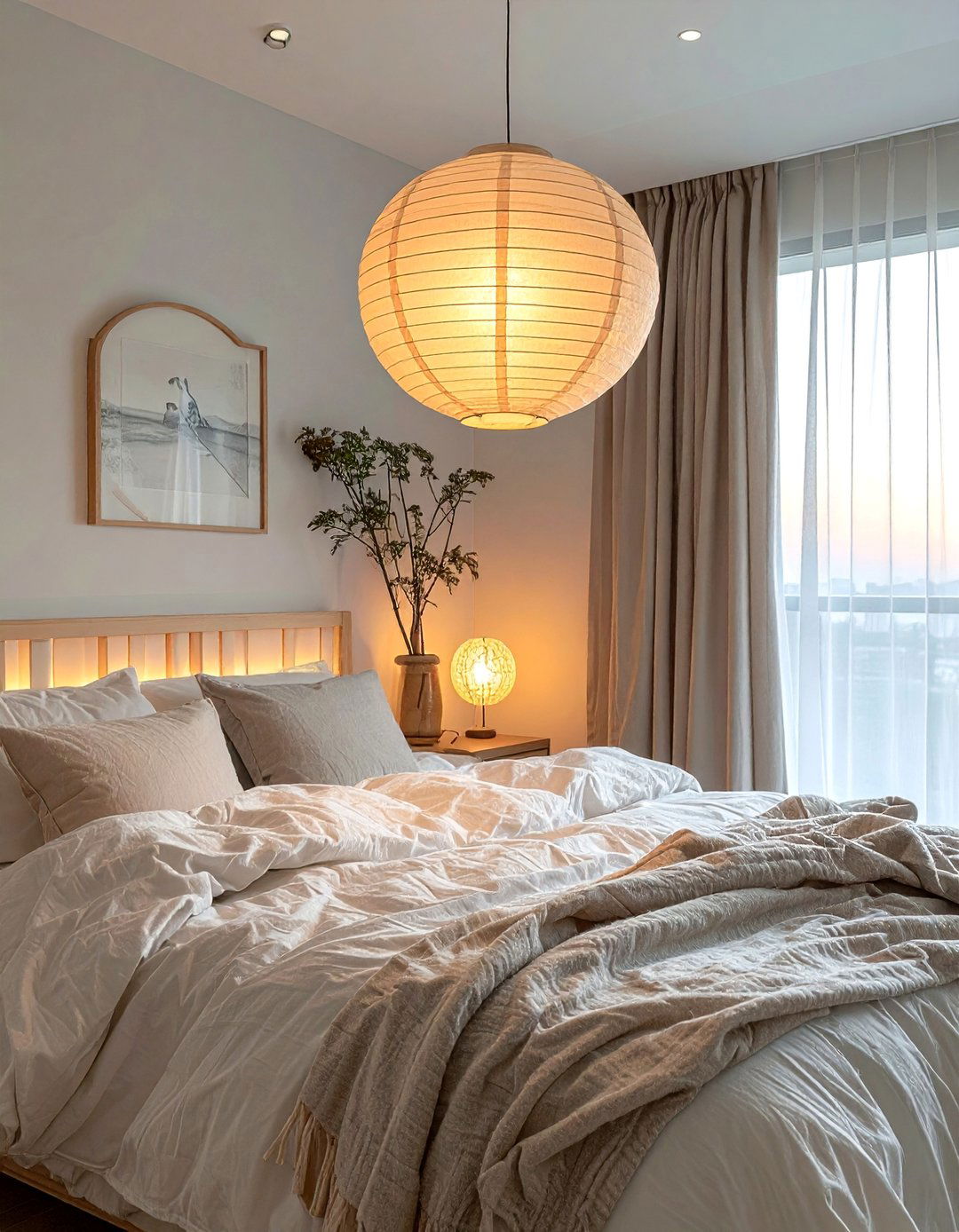
Lighting plays a crucial role in setting a serene mood, and paper lanterns are a perfect choice for a Wabi Sabi bedroom. Their delicate, translucent shades diffuse light softly, casting a warm and gentle glow that eliminates harsh shadows. Whether it’s a single, large pendant hanging from the ceiling or smaller floor lamps, paper lanterns create an ethereal and calming ambiance. Their simple, organic shapes and lightweight construction align with the principles of minimalism and natural materials. This type of lighting enhances the room's tranquil atmosphere, making it an ideal space for unwinding and finding peace at the end of the day.
13. Wabi Sabi Bedroom Incorporating Stone Elements

Stone brings a grounding, elemental force into a Wabi Sabi bedroom. This timeless material connects the space directly to the earth, offering a sense of permanence and stability. You can introduce stone in various ways, from a small river rock used as a paperweight to a slate tray on a dresser or a larger travertine side table. The natural textures, colors, and veining of stone add a layer of organic beauty and visual interest. Its cool, smooth surface provides a pleasing contrast to the warmth of wood and the softness of textiles, creating a balanced and harmonious environment that feels both ancient and profoundly calming.
14. Wabi Sabi Bedroom with Organic Shapes and Forms
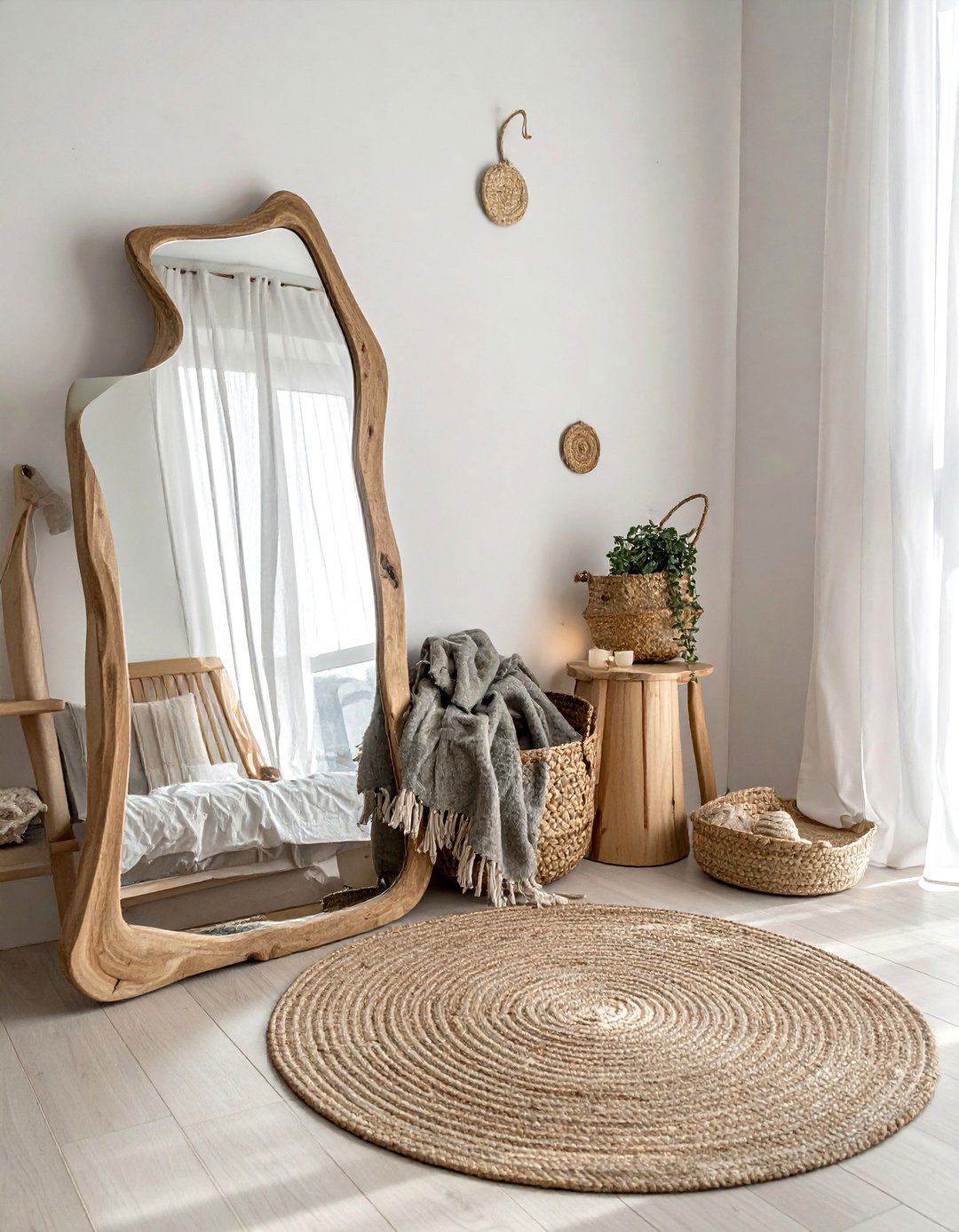
Move away from sharp angles and rigid lines by embracing organic shapes in your Wabi Sabi bedroom. Look for furniture and decor with soft, curved silhouettes that mimic forms found in nature. This could be a round jute rug, a mirror with an irregular, amoeba-like shape, or a side table crafted from a single piece of wood with its natural edges intact. These fluid forms disrupt the straight lines of the room, creating a more relaxed and visually gentle environment. Organic shapes feel more intuitive and less contrived, contributing to a sense of flow and peacefulness that is central to the Wabi Sabi aesthetic.
15. Wabi Sabi Bedroom Emphasizing Negative Space
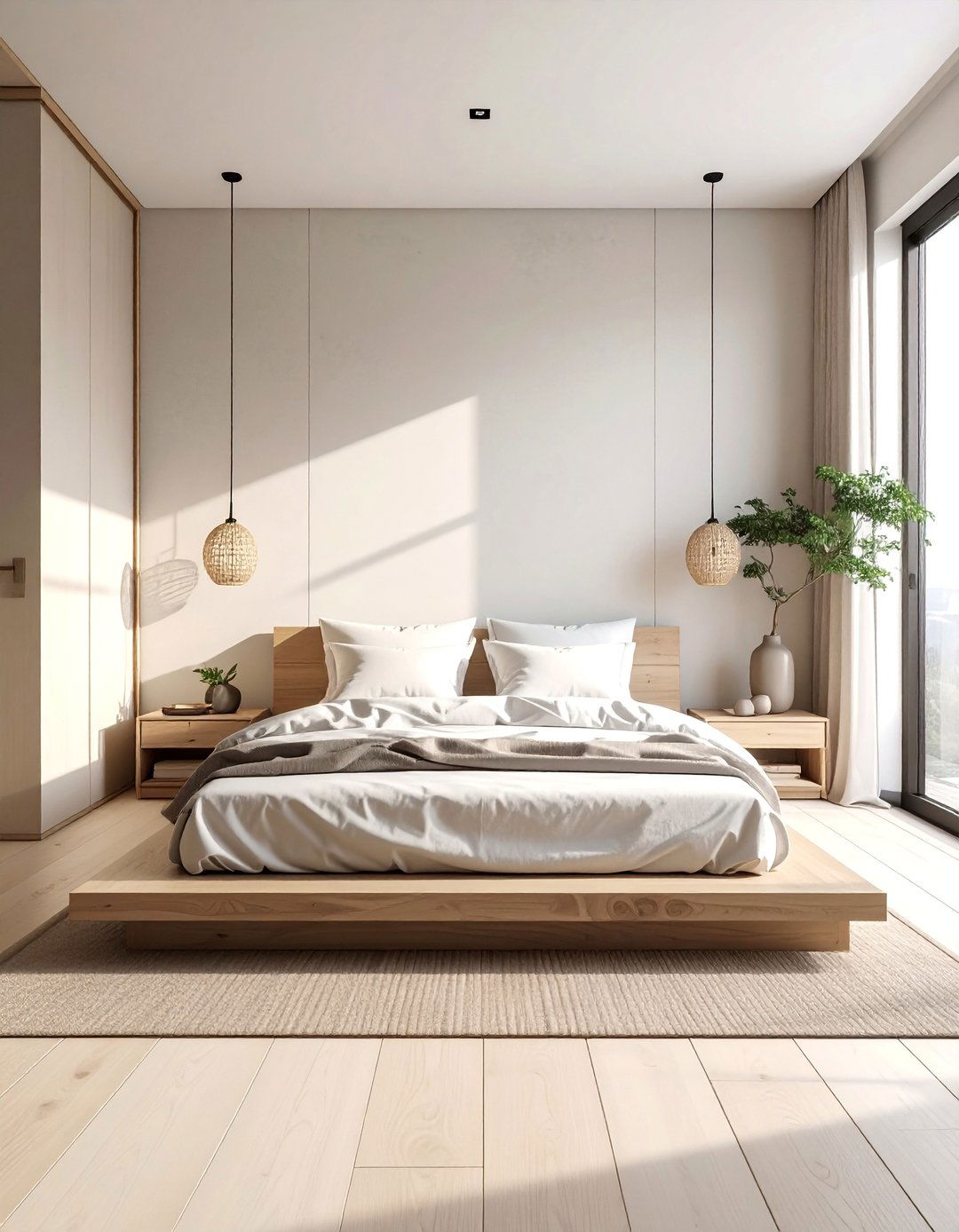
One of the most powerful principles of Wabi Sabi design is the appreciation of negative space, or "ma." A Wabi Sabi bedroom should feel uncluttered and airy, allowing room to breathe. This doesn't mean it has to be empty, but rather that every object is chosen with intention and given its own space. Avoid filling every corner and surface. A sparsely decorated wall, a clear floor area, or an empty tabletop can be just as impactful as a decorative object. This intentional lack of clutter reduces visual noise, promotes a sense of calm, and encourages a mindful appreciation of the few beautiful items you choose to display.
16. Wabi Sabi Bedroom Decorated with Clay Pottery
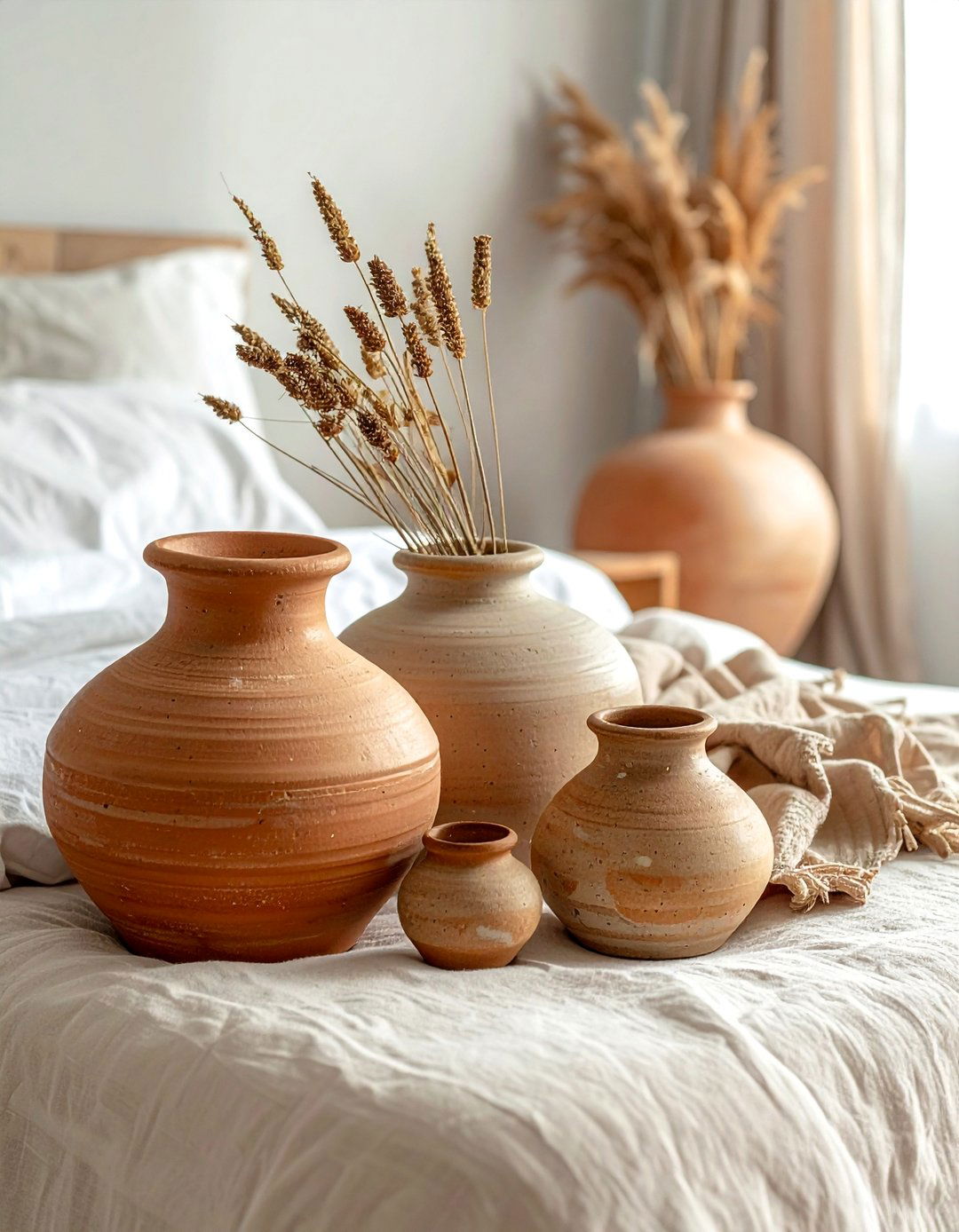
Unglazed clay and ceramic pottery are quintessential elements of Wabi Sabi decor. Their earthy origins, matte finishes, and often irregular, handmade forms make them perfect additions to the bedroom. Use a collection of small earthenware vases on a windowsill, a single large terracotta pot in a corner, or a simple clay bowl on your dresser. These pieces add a touch of rustic charm and authenticity. Their imperfect shapes and raw textures celebrate craftsmanship and the beauty of natural materials. Whether holding dried branches or standing empty as sculptural objects, clay pottery grounds the space with its humble, timeless appeal.
17. Wabi Sabi Bedroom Maximizing Natural Light

Natural light is a key ingredient in creating a serene and authentic Wabi Sabi bedroom. Instead of heavy, ornate draperies, opt for simple window treatments that allow sunlight to filter through gently. Sheer linen curtains, bamboo blinds, or even bare windows are excellent choices. The changing quality of light throughout the day becomes a dynamic feature of the room, highlighting different textures and casting soft shadows. This connection to the natural daily rhythm enhances the room's calming atmosphere. Maximizing natural light not only brightens the space but also fosters a sense of well-being and a stronger connection to the world outside.
18. Wabi Sabi Bedroom with a Focus on Simplicity

At its core, a Wabi Sabi bedroom is a testament to the power of simplicity. This means stripping away the non-essential to create a space that is pure, functional, and peaceful. Practice mindful curation by selecting only items that are either useful or truly meaningful to you. Keep surfaces clear of clutter and organize belongings out of sight in simple storage solutions like woven baskets or wooden chests. The beauty of this approach lies in its ability to quiet the mind. By simplifying your physical environment, you create mental space for rest, reflection, and a deeper appreciation for the simple, beautiful things in your life.
19. Wabi Sabi Bedroom Showcasing Items with Patina
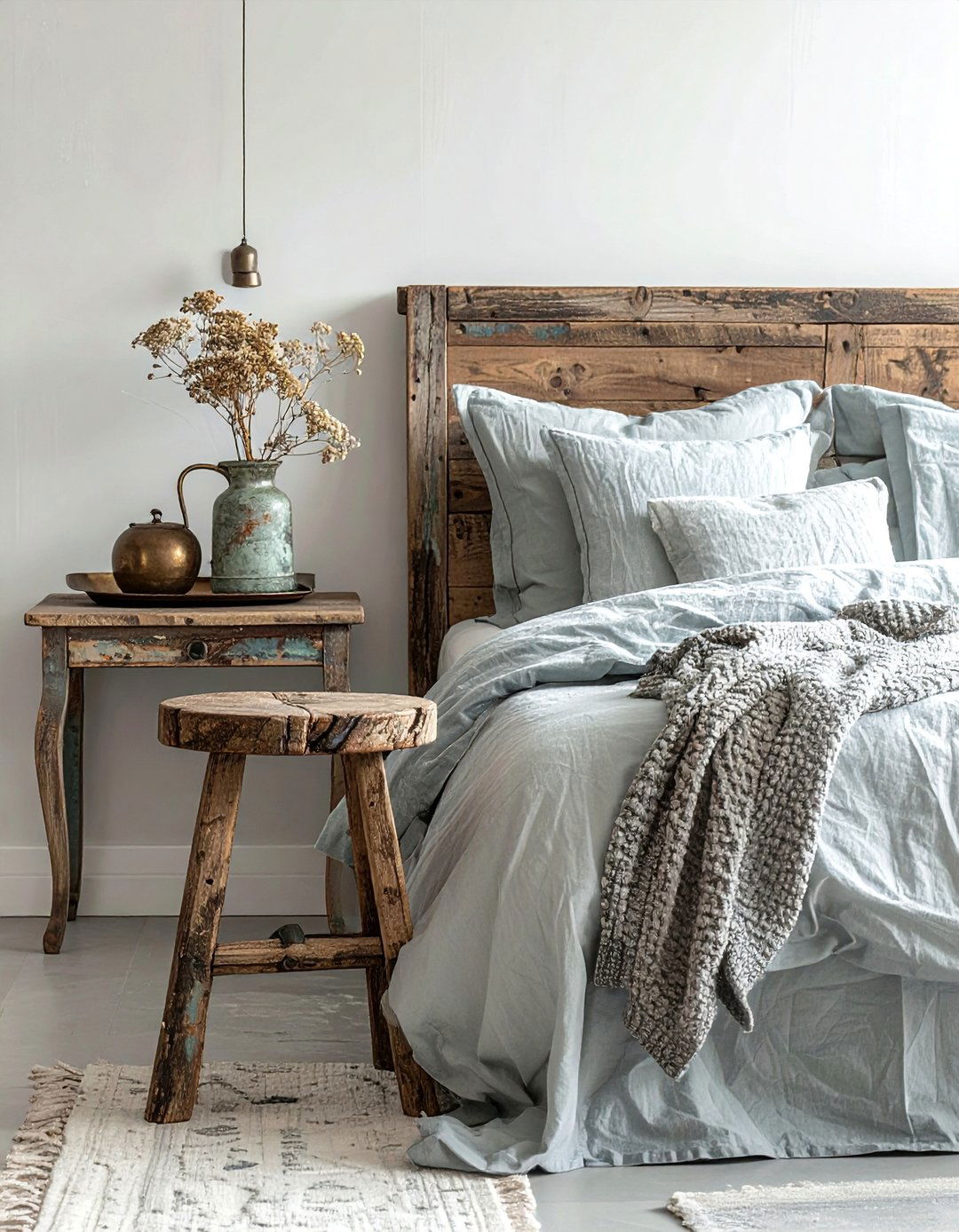
Wabi Sabi finds beauty in the marks of time and use, so incorporating items with a natural patina is a wonderful way to express this philosophy. A weathered wooden stool, a tarnished brass tray, or a piece of furniture with faded paint tells a story and adds a layer of depth that new items cannot. These signs of aging are not seen as flaws but as evidence of a life lived, adding soul and character to your bedroom. You can find such treasures at flea markets or antique stores, or simply allow your own beloved objects to age gracefully over time.
20. Wabi Sabi Bedroom Using Textural Wall Finishes
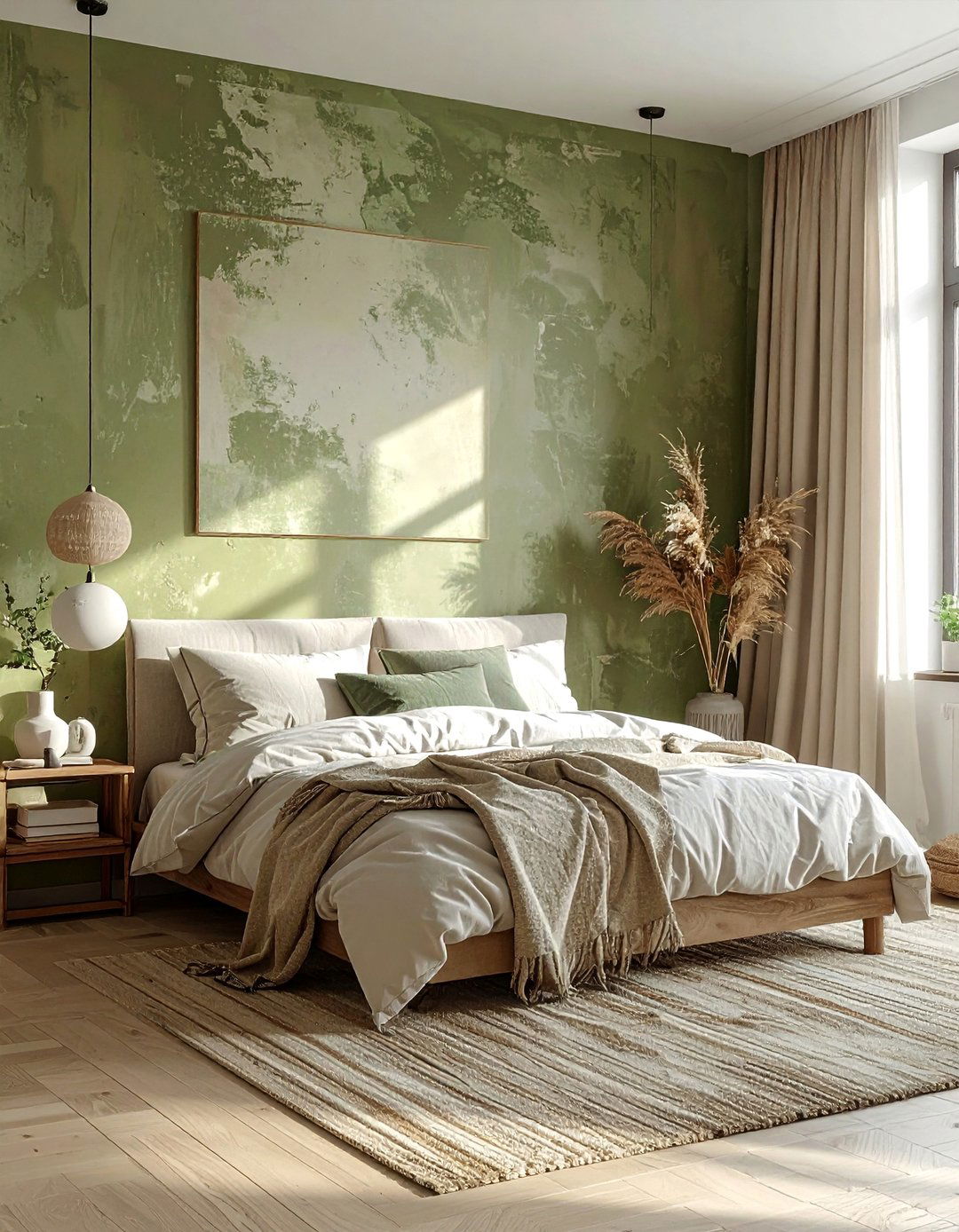
Transform the entire feel of your Wabi Sabi bedroom by focusing on the walls. Instead of a flat, perfect coat of paint, consider a textural wall finish like lime wash, tadelakt, or clay plaster. These applications create a soft, matte surface with subtle variations in color and texture, reminiscent of aged, weathered walls. The effect is incredibly warm and organic, providing a beautiful, tactile backdrop for your minimalist furnishings. This approach envelops the room in a gentle, earthy embrace, making the space feel like a cozy, natural cocoon. It’s a powerful way to add depth and character while maintaining a simple, uncluttered aesthetic.
Conclusion:
Embracing Wabi Sabi bedroom ideas is about more than just aesthetics; it's about cultivating a mindset of acceptance and finding peace in simplicity. By integrating natural materials, earthy tones, imperfect textures, and mindfully chosen objects, you create a personal sanctuary. This approach encourages a slower, more intentional way of living, where your bedroom becomes a true retreat from the chaos of the outside world. Ultimately, a Wabi Sabi bedroom is a beautifully imperfect space that nurtures the soul, celebrates authenticity, and provides a backdrop for serene and restful living.

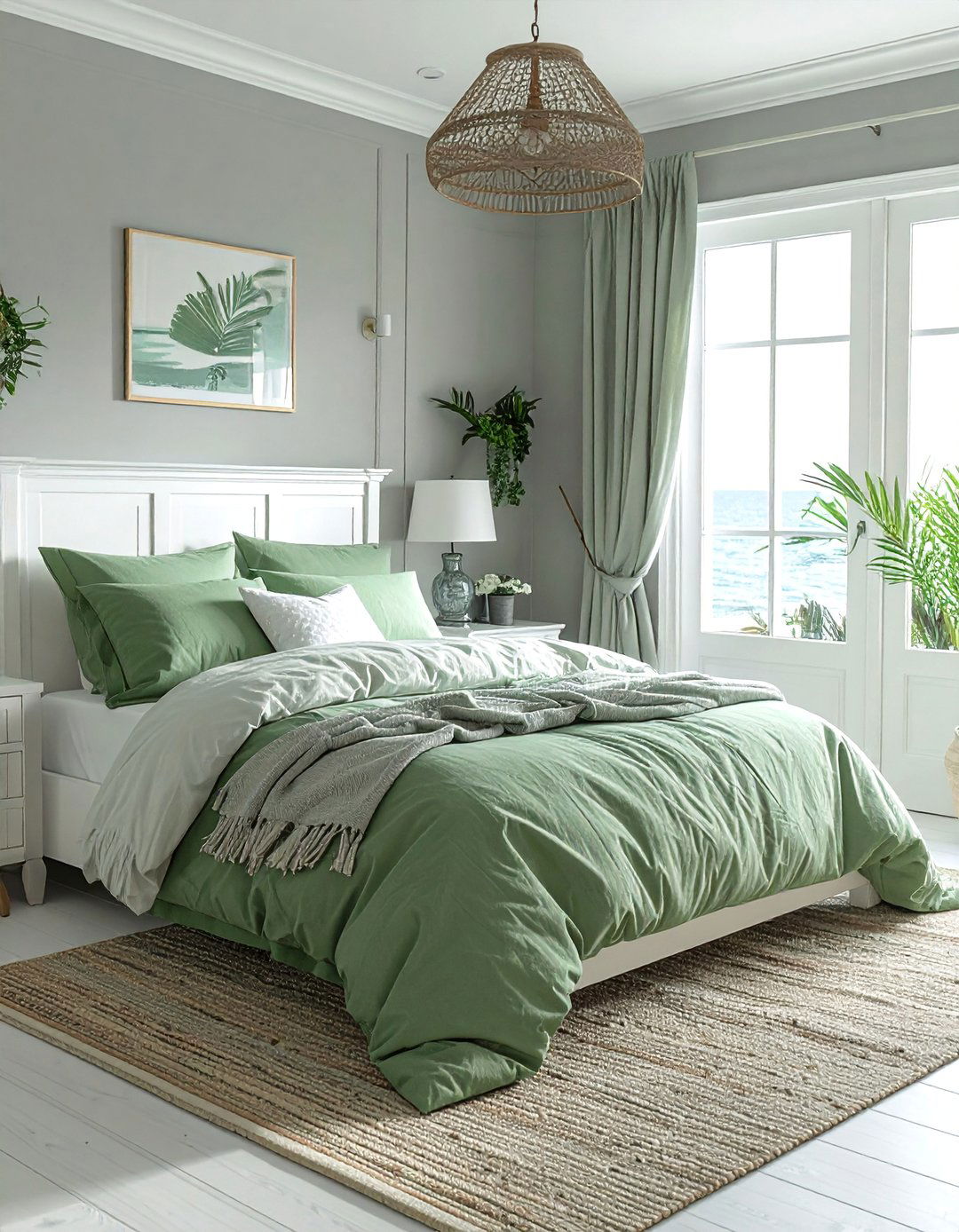

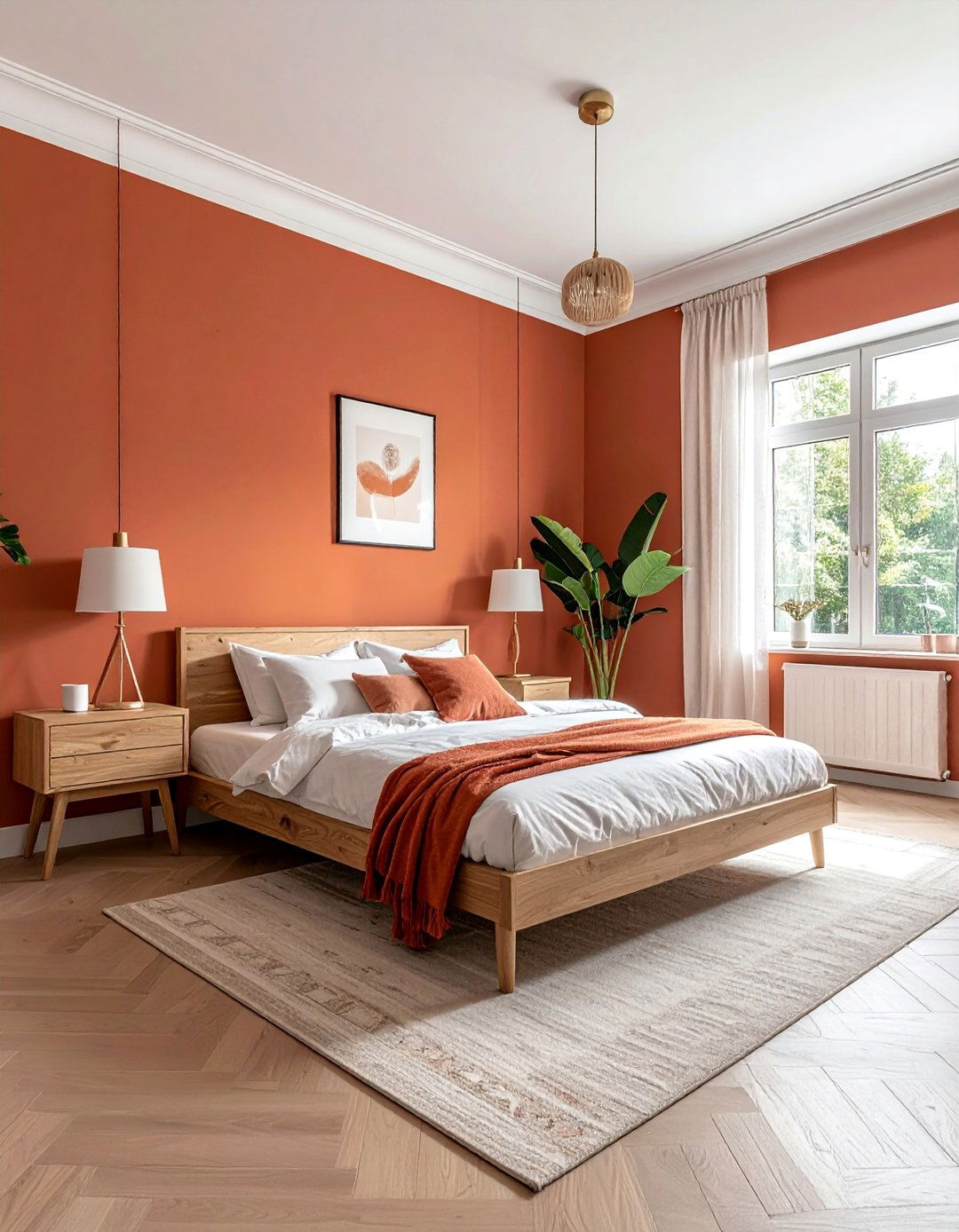
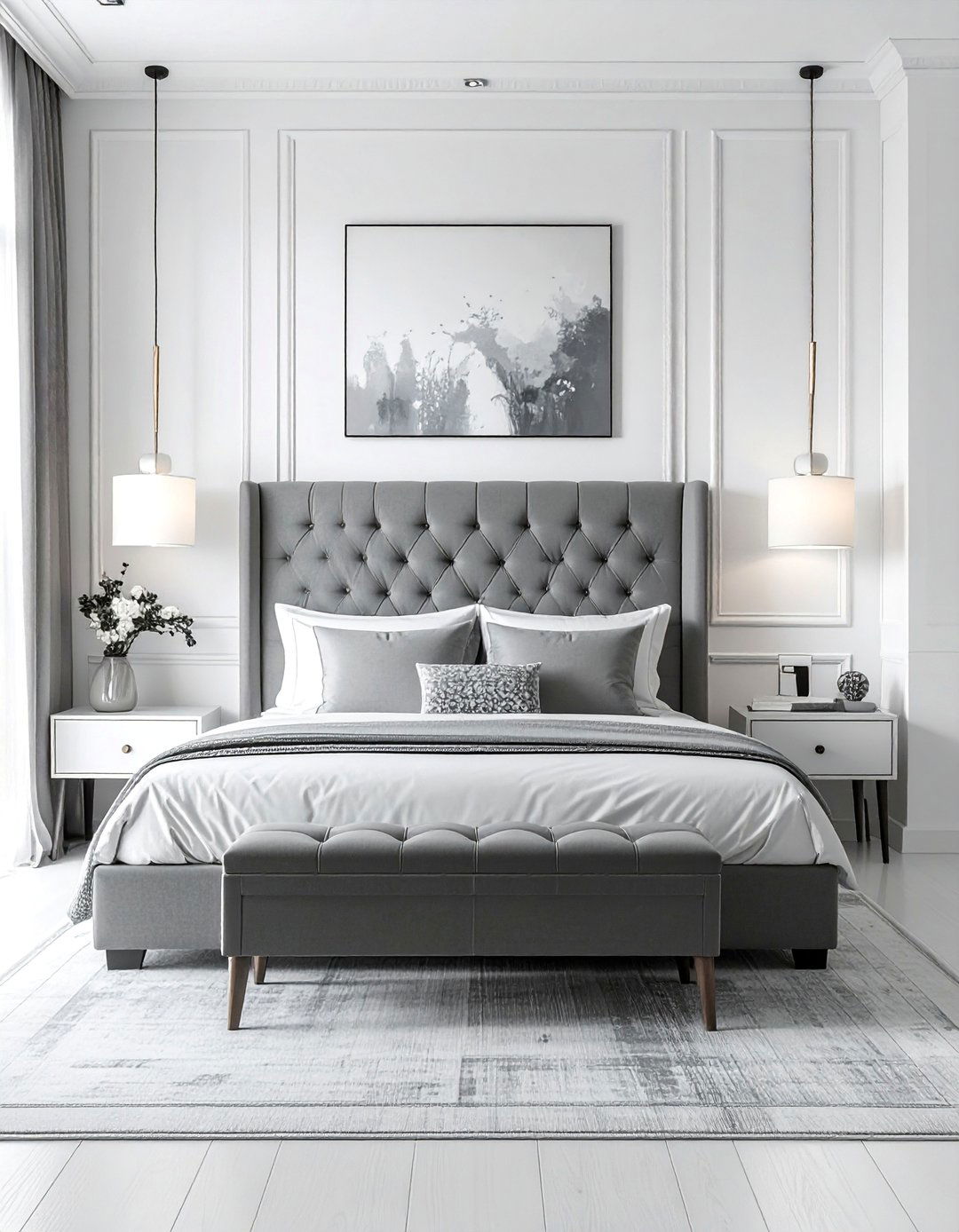

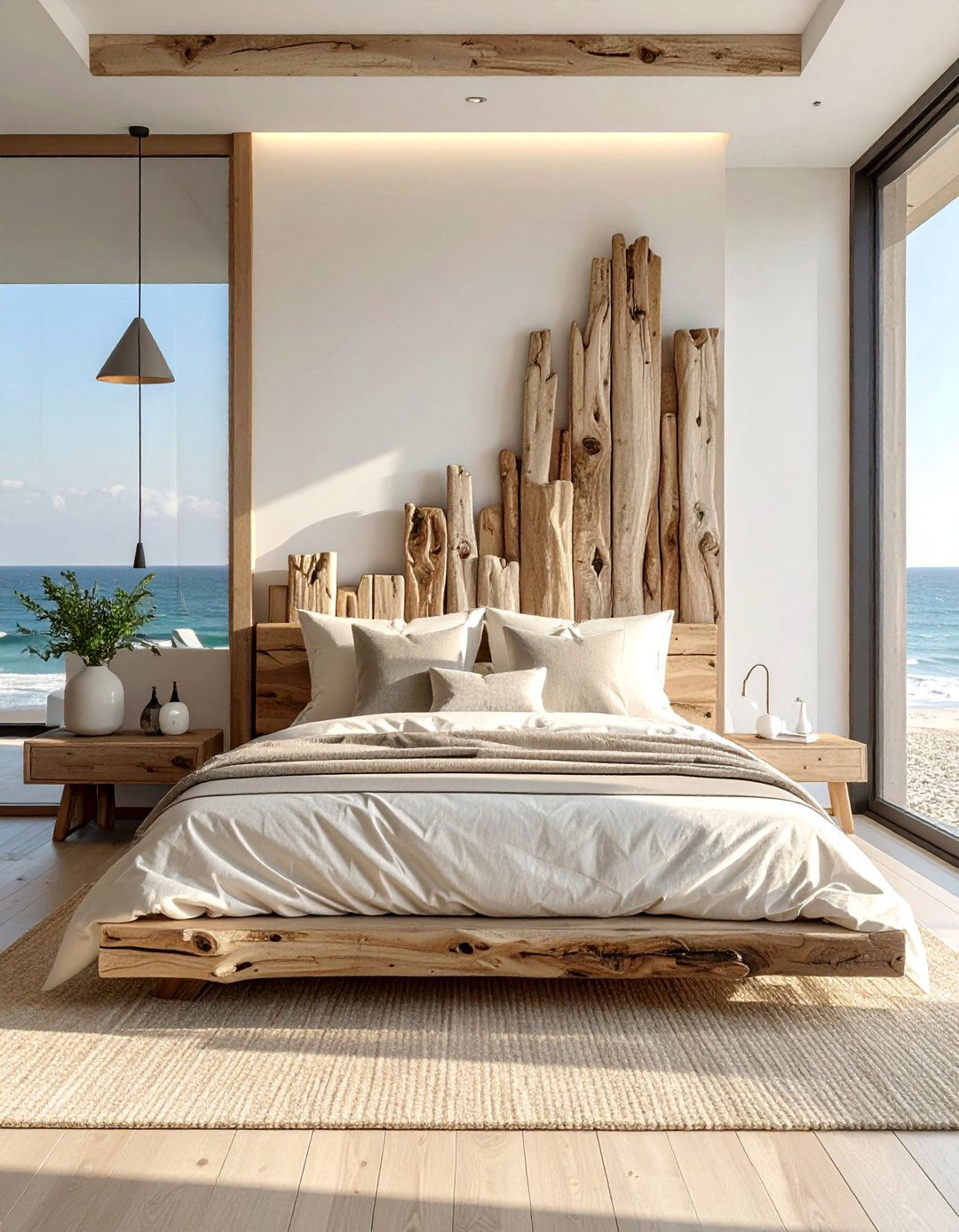
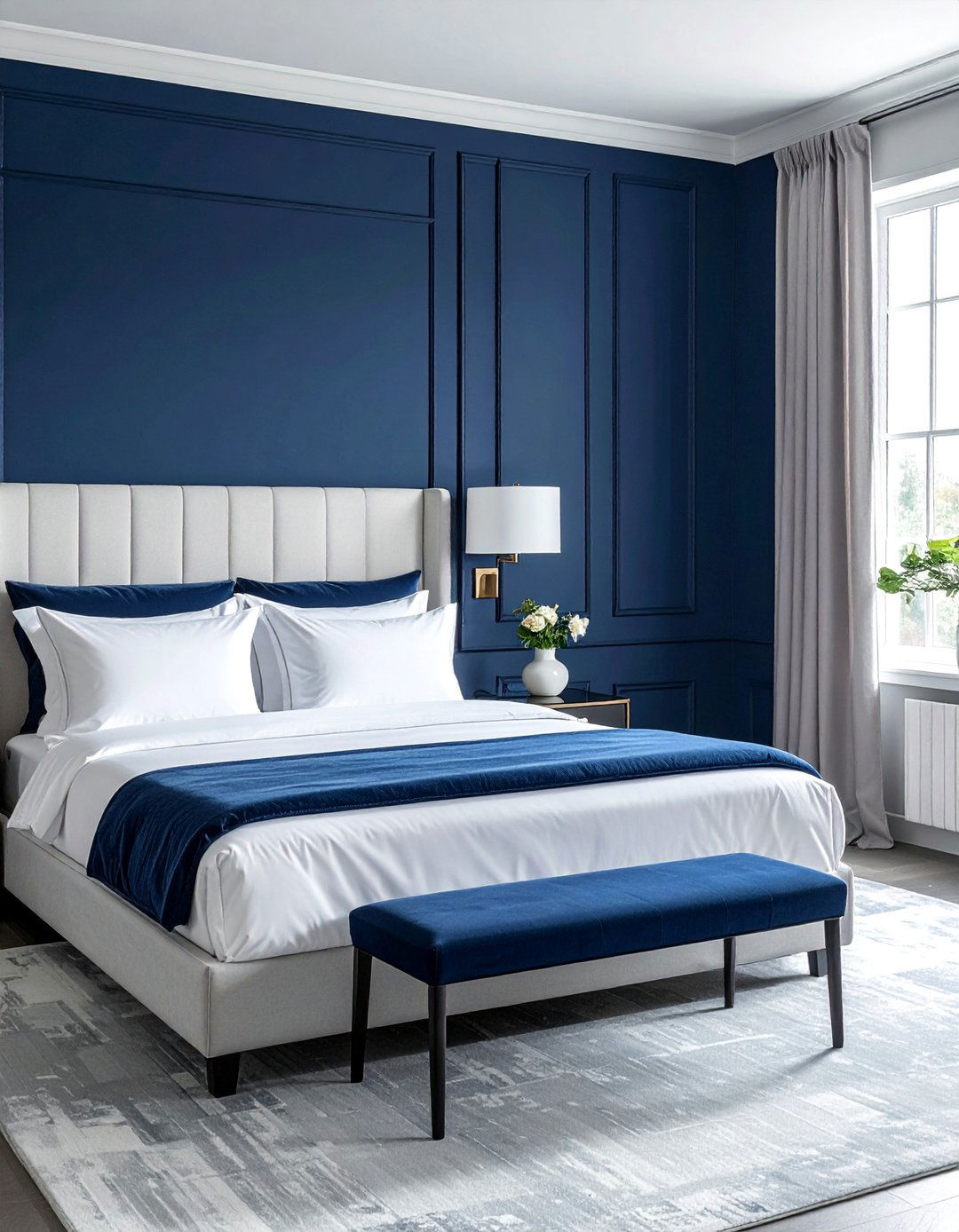
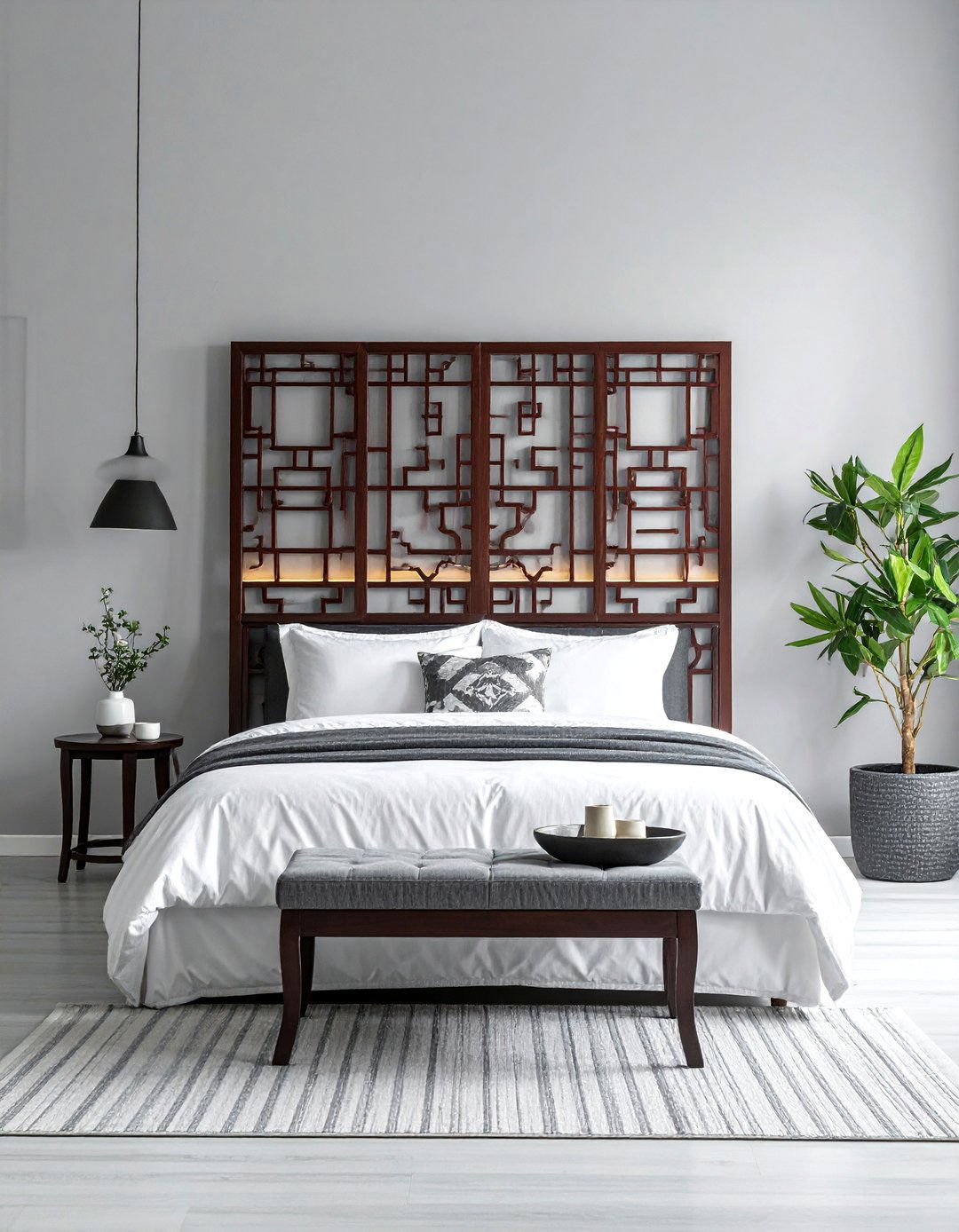
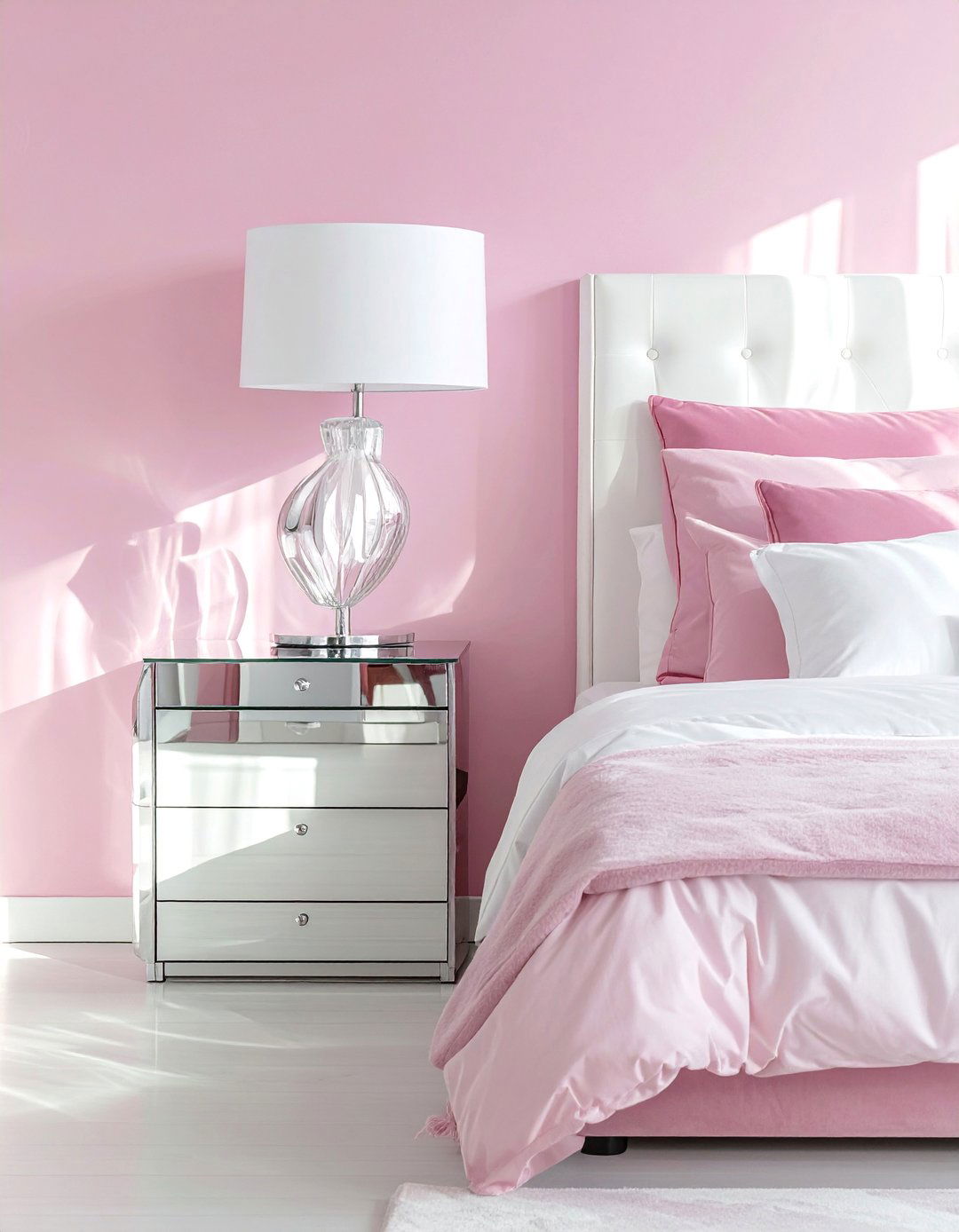
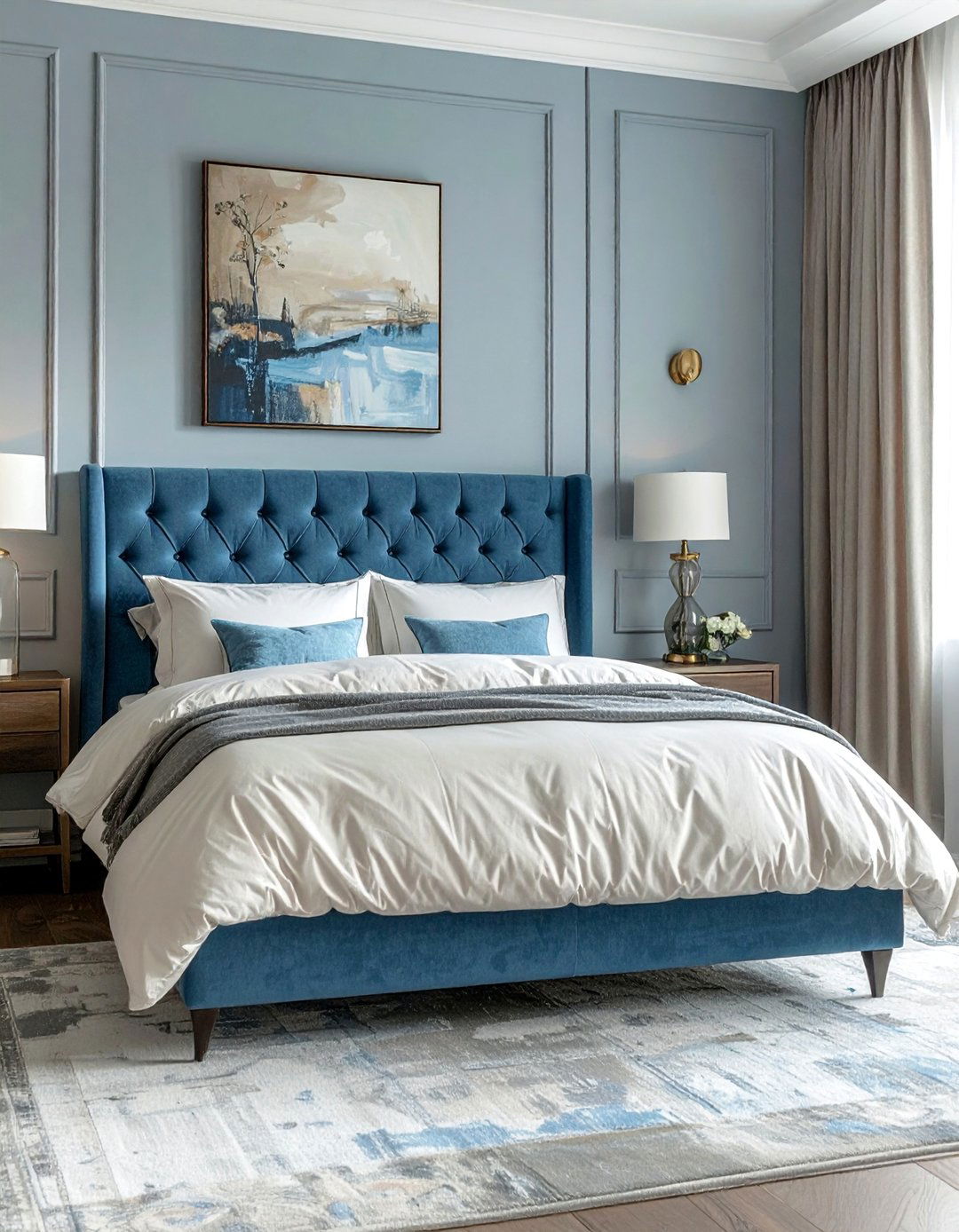
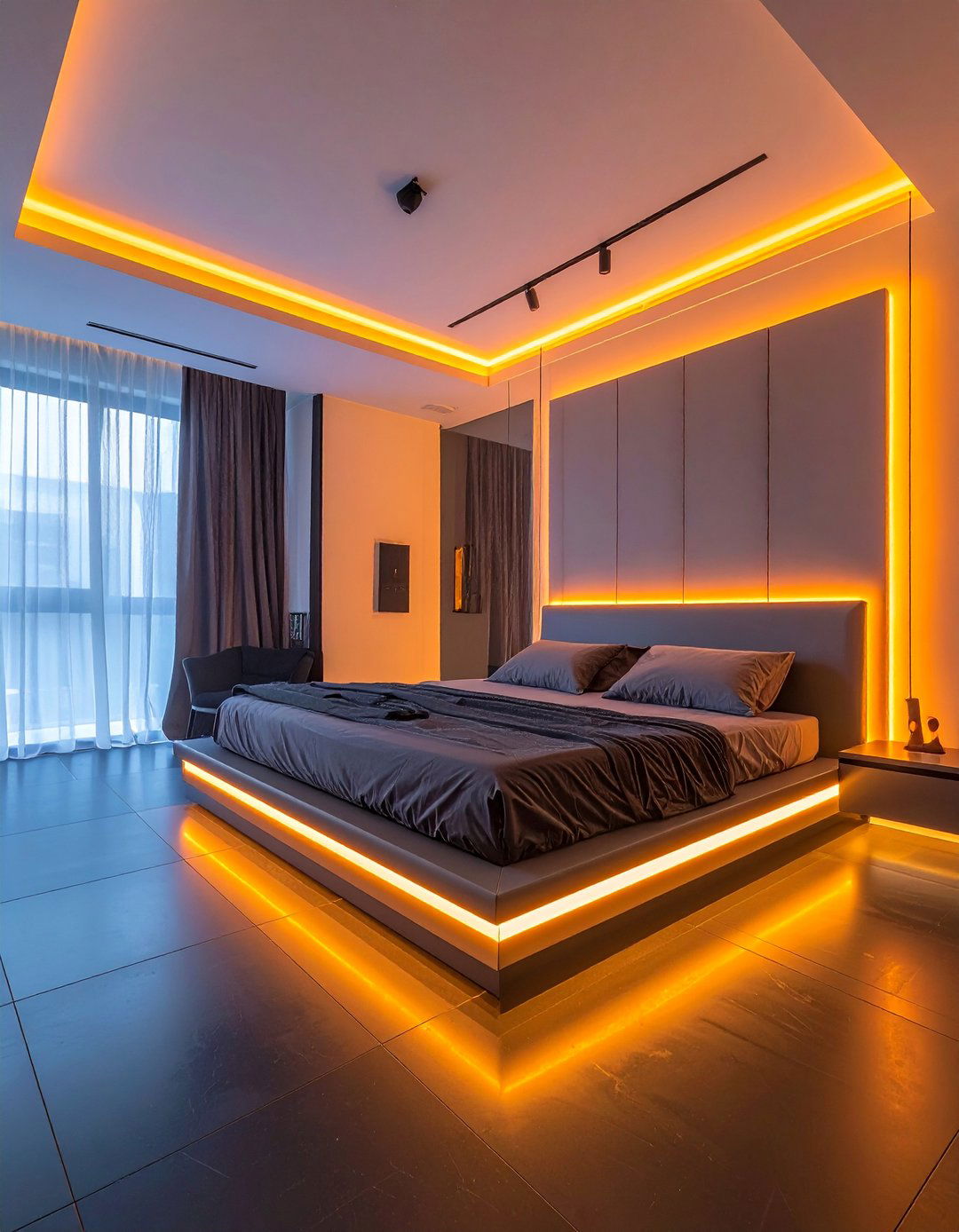

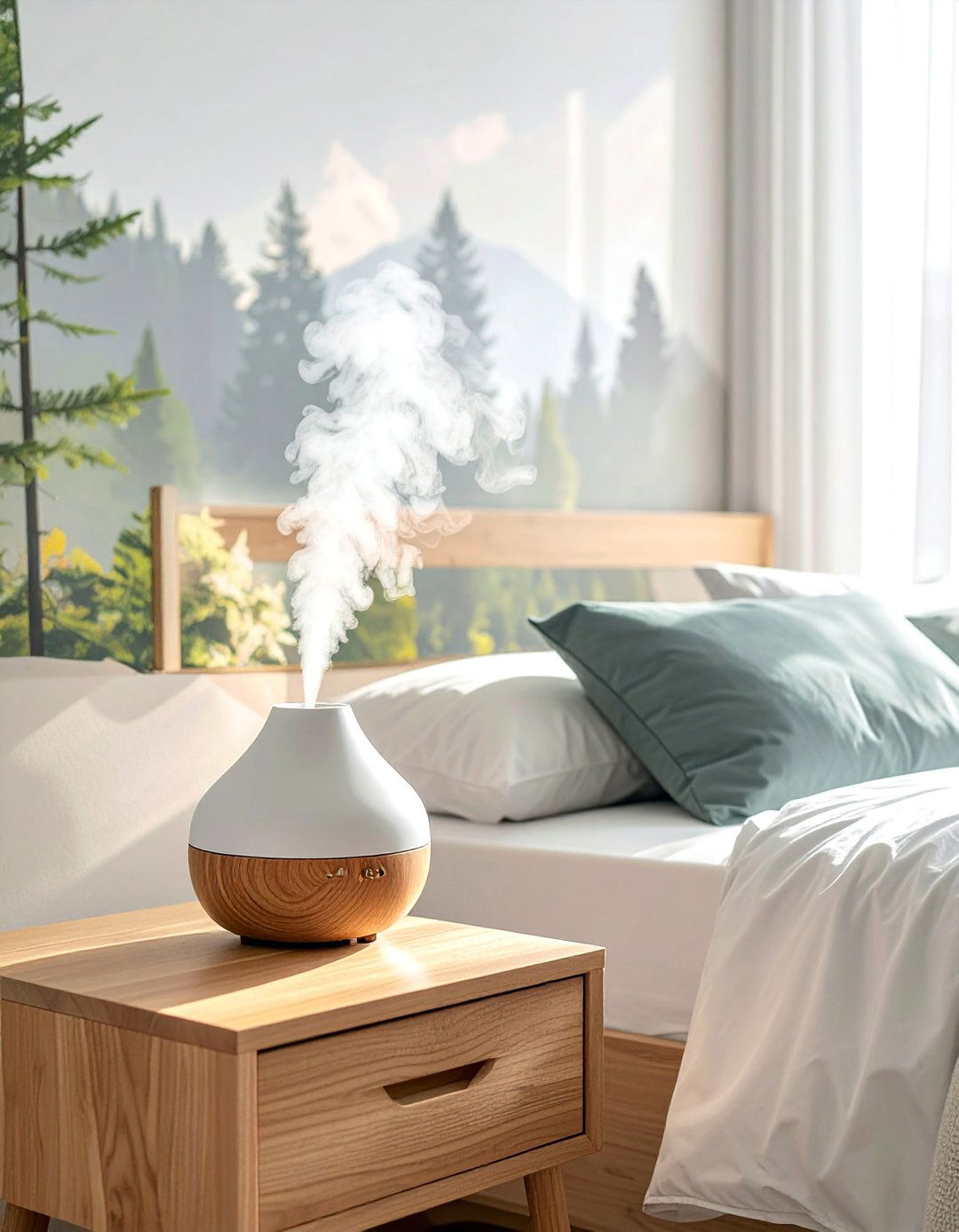

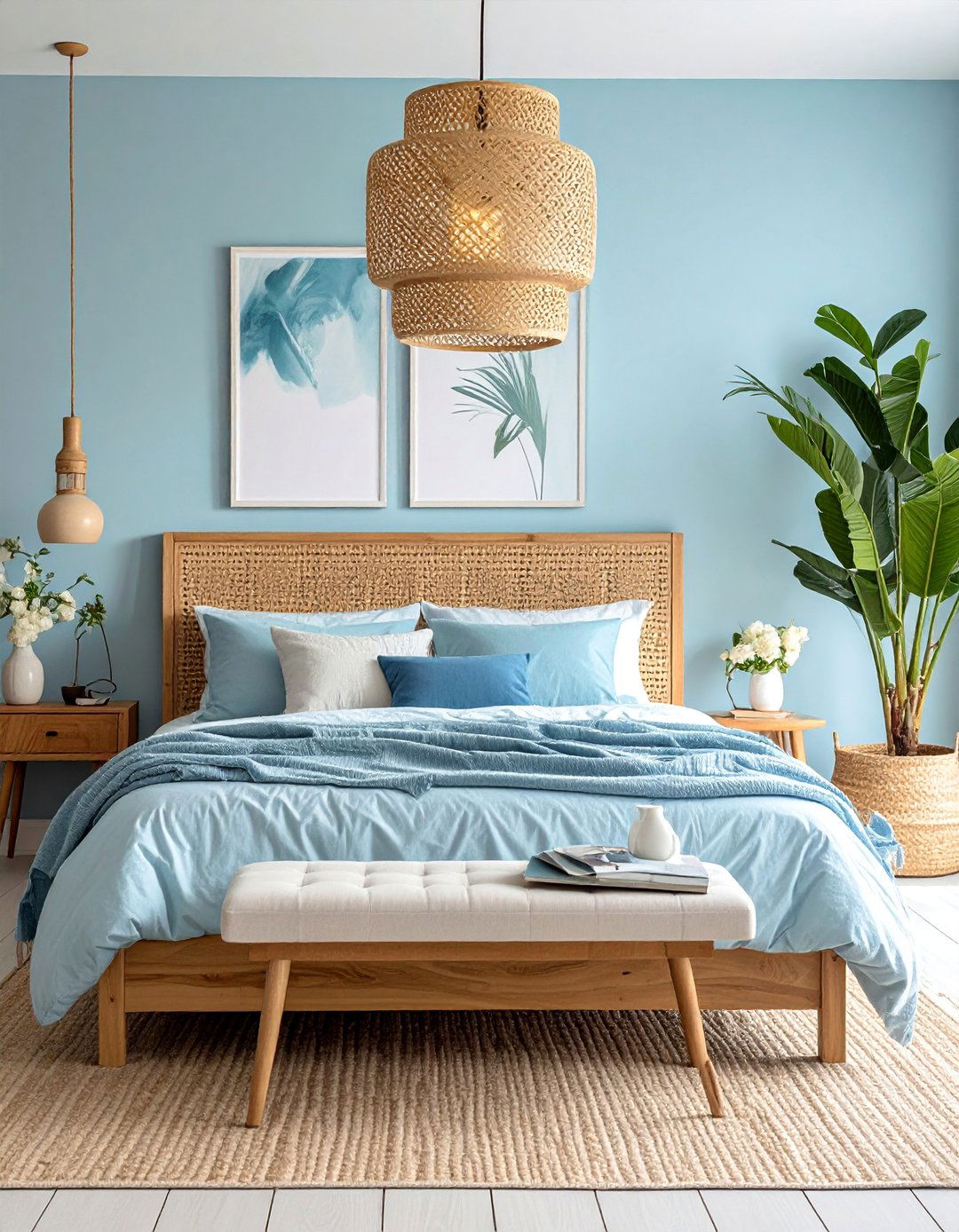
Leave a Reply